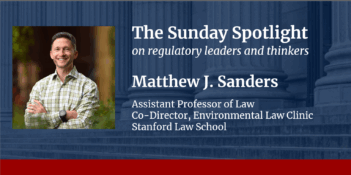
Revising FERC’s open access tariff rules would reverse 40 years of progress.
The Federal Energy Regulatory Commission (FERC) is considering adopting a proposal that would reverse 40 years of significant progress in regulating energy markets.
FERC’s proposal responds to U.S. Secretary of Energy Rick Perry’s call for a major revision of non-discriminatory open access tariffs that have guaranteed that each wholesale purchaser of electricity is charged a comparable price for a comparable amount of electricity. Secretary Perry’s proposal would single out nuclear and coal-fired generating plants for special benefits by ensuring they can recover fully allocated rates of return.
If FERC were to adopt the Secretary’s proposal, it would turn back decades of progress. In the 1970s, the markets for natural gas and electricity performed poorly. Numerous studies identified the methods of regulation used by FERC’s predecessor, the Federal Power Commission (FPC), as one of the primary sources of the poor performance of the energy markets. FPC’s heavy reliance on cost-of-service ratemaking rendered it impossible for the natural gas and electricity markets to perform effectively.
FERC responded to this regulatory crisis admirably. During the 1980s, FERC completely changed its methods of regulating the natural gas market. It eliminated the horrible distortions that had been created by cost-of-service regulation by adopting methods of regulation that allowed market forces to play the dominant role in shaping prices and allocating resources. FERC’s reforms resulted in many beneficial effects, including elimination of shortages and availability of more affordable energy for consumers.
FERC embarked on a similar effort to restructure the electricity market and to reform its regulation in the 1990s. That effort has been a complete success in regions of the country that include most of the U.S. population. In those regions, regional transmission operators (RTO) or independent system operators (ISO) operate the transmission grid and ensure that all generators have equal access to the grid. Through this mechanism, FERC has allowed market forces to replace regulation as the primary determinant of which sources provide electricity in the wholesale market.
As an August Energy Department report describes in detail, the large numbers of recent closures of old coal-fired generating plants, and the expected future closure of more old coal-fired plants and old nuclear plants, is entirely consistent with the market-based system of regulation that FERC has created. Virtually every page of that report includes statements such as “the biggest contributor to the coal and nuclear plant retirements has been the advantaged economics of natural gas-fired generation.” The much older, less efficient, less flexible coal and nuclear generating plants are no longer able to compete effectively against the newer, more efficient, lower cost sources of electricity that are now available.
If FERC adopts the Secretary of Energy’s proposal, FERC would be reversing the direction of the reforms it has undertaken over the past 40 years, overruling the forces of the marketplace and compelling the nation’s consumers to buy electricity from the most inefficient, highest cost sources at a very high price.
Every decision to overrule market forces costs consumers, and the Secretary’s proposal would impose extremely high costs on consumers. The proposal is intended at a minimum to avoid the retirement of a significant amount of coal-fired and nuclear generating capacity. The proposal may even contemplate bringing back online all or part of the coal capacity retired over the past decade and a half. The notice proposes to keep these plants online by ensuring that each of these units “recovers its fully allocated costs including a fair return on equity.”
In short, the Energy Department proposes to move the oldest, most expensive, least efficient generating units to the top of the queue of resources ahead of all of the less expensive, more efficient sources and to ensure that they are paid more than any other source. The cost to consumers of this decision to overrule market forces would be extremely high.
The Energy Department attempts to justify its proposal based on what it describes as an “urgent” need for “immediate action” to create a reliable and resilient electricity market. The report that the Secretary of Energy’s staff prepared earlier this year puts the situation in a more realistic perspective, stating that “markets recognize and compensate reliability, and must continue to compensate reliability, but more work is needed to address resilience.” That sober assessment of the status quo is well supported by the detailed analysis in the Energy Department’s excellent report.
As FERC well knows, markets operated by ISOs and RTOs must accomplish two goals simultaneously. First, these markets must create prices that encourage market participants to allocate resources efficiently. Second, the markets must yield prices that encourage participants to make long-term investments in generating capacity that can be called upon at any time and that is adequate to satisfy the demand for electricity in widely varying circumstances. The Secretary of Energy’s notice refers to some of the many proceedings in which FERC has considered ways to ensure these challenging twin tasks are achieved.
The proposed rule acknowledges FERC’s recent success in persuading the U.S. Court of Appeals for the District of Columbia Circuit to uphold FERC’s bold new approach to improving the reliability and resilience of the electricity market. In December 2014, PJM, the largest and oldest ISO, submitted proposed revisions to the rules governing its capacity market. PJM maintained that its preexisting capacity market rules were not adequate to ensure reliable electricity service in its market area. It proposed to revise its rules to provide for increased penalties against firms that commit capacity but fail to fulfill their commitments.
After conducting extensive hearings, FERC agreed with PJM and approved its revisions in an order issued in June 2015 an order the D.C. Circuit upheld this year. To the extent that there was a reliability or resilience problem in the PJM market, FERC has effectively addressed that problem. If FERC believes that there are serious reliability or resilience problems in markets served by other ISOs and RTOs, it already has access to an effective FERC-approved and court-tested solution to the problem.
The Secretary of Energy argues that “immediate action” is needed to address the “crisis,” albeit a “crisis” that the Energy Department’s staff did not detect. He argues that FERC can approve his proposal quickly because of the “vast record” it has amassed on price formation. To its credit, FERC has indeed developed such a vast record. I have no doubt that it will continue to use that record and its expertise to continue to develop and to implement methods of price formation that will provide the continued reliability and resilience required in U.S. electricity markets.
That vast record is useless, however, for purposes of evaluating the Secretary’s proposal. No one has previously proposed substituting the oldest, most technologically, economically, and environmentally obsolete generating units for the newest, most technologically, economically, and environmentally efficient generating units as a means of improving the reliability and resiliency of the grid. As a result, FERC has not had a prior opportunity to consider such an absurd proposal. The Secretary has now provided FERC with that opportunity.
The “solution” urged by the Secretary is not just ineffective and counterproductive. It would not only lead to higher prices for consumers, but it would also have disastrous environmental effects. We cannot know the details of the environmental effects of the Secretary’s proposal until FERC prepares an environmental impact statement (EIS), but it is obvious that it is intended to, and would, increase significantly the use of coal-fired generating units. That, in turn, would increase dramatically emissions of particulate matter and carbon dioxide.
Rulings from the U.S. Environmental Protection Agency that particulate matter kills thousands of people a year and that carbon dioxide is a pollutant, the emission of which endangers public health, have been upheld in the courts. Beyond that, the D.C. Circuit has also held that FERC must consider the effects of pipeline construction on carbon dioxide omissions before FERC can authorize the construction of several interstate natural gas pipelines.
The action urged by the Secretary in the proposed rule would have far greater negative effects in terms of increasing the emissions of carbon dioxide than would the authorization of the construction of those pipelines. FERC can take no action of the type urged by the Secretary without first preparing an EIS.
The Secretary argues that FERC is not required to prepare an EIS because FERC’s rules provide a categorical exemption for actions on tariff filings related to rates. That argument does not work. An agency rule cannot contradict a statute. The National Environmental Policy Act requires an agency to prepare an EIS when it takes a major federal action that significantly affects the quality of the human environment. FERC’s blanket exemption for actions related to tariff filings makes sense since it would be a rare action on a tariff filing that would have a significant effect on the quality of the human environment.
But this is that rare case. It is hard to imagine any action FERC could take that would have a greater effect on the environment than to approve the proposal the Secretary makes in this case. At a minimum, FERC should prepare an EIS of its proposed rule. But mostly it should reject Secretary Perry’s senseless and destructive proposal.
This essay is adapted from a comment Professor Pierce submitted to FERC in response to its notice of proposed rulemaking.




